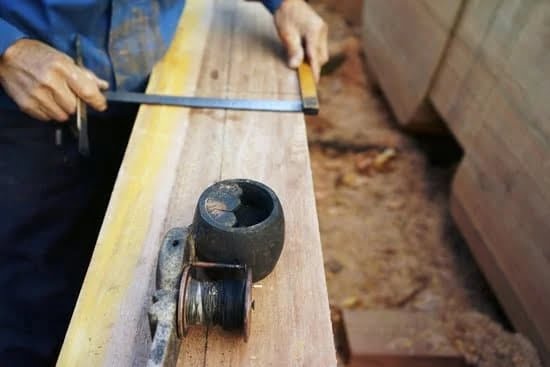Woodworking is an art that has been practiced for centuries, with traditional woodworking tools serving as the foundation for this timeless craft. From chisels and hand planes to saws and machines, these tools have played a pivotal role in shaping wood into exquisite masterpieces.
In this article, we will delve into the fascinating world of traditional woodworking tools, exploring their history, evolution, and the advantages they offer to woodworkers. We will also take a closer look at some specific tools like hand planes, hand saws, and chisels, discussing their types, uses, and techniques.
Traditional woodworking tools trace back their origins to ancient times and have evolved over the years to cater to the needs of woodworkers. These hand-operated tools have stood the test of time, embodying craftsmanship and precision that are unparalleled in modern machinery. Woodworkers who have had the privilege of working with these traditional tools understand the unique connection they foster between the artisan and their work.
One of the hallmarks of traditional woodworking is its ability to create intricate designs and details with utmost care. Traditional hand planes allow woodworkers to achieve smooth surfaces and precise angles by skillfully manipulating the tool across wooden surfaces. Equally indispensable are traditional hand saws that provide versatility and charm in making accurate cuts through various types of wood.
In this article, we aim to celebrate the beauty and mastery of traditional woodworking tools. We will explore different types of tools that every woodworker should have in their toolbox, as well as discuss the advantages they offer in terms of timeless craftsmanship and precision. Join us on this journey as we embrace the charm of traditional woodworking tools while unraveling their techniques and exploring ways to care for them so as to preserve their legacy for future generations.
The History and Evolution of Traditional Woodworking Tools
Woodworking is a craft that dates back thousands of years, and the tools used by woodworkers have evolved and changed over time. The history of traditional woodworking tools is rich and fascinating, showcasing the ingenuity and craftsmanship of generations past. From ancient times to the present day, these tools have played a crucial role in shaping the world around us.
In ancient civilizations such as Egypt, Mesopotamia, and China, woodworking was already well-established as a trade. The earliest woodworking tools were simple handheld implements like axes, chisels, and adzes. These early tools allowed artisans to shape wood into functional objects such as furniture and construction materials for buildings.
As civilizations advanced, so did their woodworking techniques and tools. In ancient Greece and Rome, more sophisticated hand tools like saws and planes were developed. Woodworking became an important skill in constructing elaborate structures such as temples, theaters, and ships.
During the Middle Ages, woodworking guilds emerged in Europe, bringing with them a greater emphasis on craftsmanship and specialization. This period saw the development of more complex hand tools like braces (used for drilling holes) and gouges (used for carving).
With the advent of industrialization in the 18th century came significant advancements in woodworking technology. Power-driven machinery was introduced into workshops, making it possible to produce large quantities of wooden items quickly and efficiently.
Today, traditional woodworking tools are still beloved by many artisans who appreciate their connection to history and the craftsmanship they offer. While modern power tools can perform tasks more quickly, traditional hand tools allow for greater precision and control.
Overall, the evolution of traditional woodworking tools reflects both societal changes and advancements in technology. From simple handheld implements to complex machines, these tools have stood the test of time and continue to be cherished by craftsmen worldwide.
| Time Period | Tools |
|---|---|
| Ancient civilizations (Egypt, Mesopotamia, China) | Axes, chisels, adzes |
| Ancient Greece and Rome | Saws, planes |
| Middle Ages | Braces, gouges |
| 18th century industrialization | Power-driven machinery |
Essential Traditional Woodworking Tools Every Woodworker Should Have in their Toolbox
Traditional woodworking is a craft that relies heavily on the use of specialized tools to shape and manipulate wood into various forms. Whether you are just starting out or have been working with wood for years, there are certain essential traditional woodworking tools that every woodworker should have in their toolbox. These tools not only help you achieve accuracy and precision in your work but also enhance the overall experience of working with wood.
- Hand Plane: A hand plane is one of the most fundamental traditional woodworking tools that every woodworker should have. It is used for flattening, smoothing, and shaping wooden surfaces. There are several types of hand planes available, including bench planes, block planes, and specialty planes like shoulder planes and router planes.
- Chisels: Chisels are versatile tools used for carving, shaping, and detailing wood. They come in different sizes and shapes to suit various purposes. Beveled edge chisels are commonly used for general woodworking tasks, while mortise chisels are designed specifically for creating mortise joints.
- Hand Saw: A good-quality hand saw is an indispensable tool for any woodworker. It enables you to make precise cuts in wood quickly and efficiently. Rip saws are used for cutting along the grain of the wood, while crosscut saws are designed to cut across the grain.
- Mallet: A mallet is a wooden or rubber-headed hammer-like tool that is used to strike other tools such as chisels or wooden pegs without damaging them. It provides controlled force when working on delicate tasks or driving chisels into wood.
- Marking and measuring tools: Accurate measurements are crucial in traditional woodworking projects. Essential marking and measuring tools include a tape measure or ruler for length measurements, a marking gauge for marking parallel lines or specific distances from an edge, a combination square for checking corners and angles, and a marking knife or pencil for accurate layout lines.
Having these essential traditional woodworking tools in your toolbox ensures that you have the basic equipment needed to start working on woodworking projects. While there are many other specialized tools available, these core tools will allow you to tackle a wide range of tasks and develop your skills as a woodworker. Remember to invest in high-quality tools and take the time to maintain and care for them properly to ensure their longevity and effectiveness.
The Advantages of Using Traditional Woodworking Tools
Traditional woodworking tools hold a significant advantage over their modern counterparts in terms of timeless craftsmanship and precision. While power tools may offer efficiency and speed, traditional tools provide woodworkers with a unique experience that cannot be replicated.
One of the main advantages of using traditional woodworking tools is the level of mastery and skill required to use them effectively. These tools often require manual manipulation and technique to achieve the desired results, making each piece a true work of art. Woodworkers who choose to use traditional tools can develop a deeper understanding of the craft and feel a stronger connection to their work.
In addition to the element of craftsmanship, traditional woodworking tools also offer unparalleled precision. Hand planes, saws, and chisels allow woodworkers to have complete control over every cut, shave, or carve they make. This level of precision is crucial when working on intricate designs or delicate pieces where even the slightest deviation can ruin the final product. Woodworking enthusiasts can rely on traditional tools to achieve impeccable results that showcase their attention to detail.
Furthermore, traditional woodworking tools allow for greater customization and adaptability compared to their modern counterparts. With these hand-tools, woodworkers have more flexibility in terms of shaping wood and creating unique designs. Whether it’s adding intricate details or making complex joinery cuts, traditional tools give craftsmen the freedom to bring their creative visions to life.
To experience the advantages of using traditional woodworking tools fully, it is important for woodworkers to understand how each tool works and familiarize themselves with proper techniques. By maintaining a high level of skill and craftsmanship through practice and experimentation, woodworkers can continue to uphold the legacy of traditional woodworking while producing exceptional pieces that stand out in today’s modern world.
- Mastery and skill required
- Precision control over every cut
- Greater customization and adaptability
A Closer Look at Traditional Hand Planes
Traditional hand planes are an essential tool in the woodworking world. They have been used for centuries and continue to be favored by many craftsmen today. Hand planes come in various types, each with its unique purpose and functionality. Understanding the different types, uses, and techniques of traditional hand planes is crucial for any woodworker looking to achieve precision and excellence in their craft.
One of the most common types of traditional hand planes is the bench plane. This versatile tool is used for smoothing and flattening surfaces. It typically has a wide, flat sole that allows it to glide smoothly across the wood. The bench plane comes in different sizes, with each size serving a specific purpose. Smaller bench planes are suitable for fine smoothing tasks, while larger ones are ideal for heavier stock removal.
Another type of hand plane is the block plane. This compact and lightweight tool can be held with one hand, making it convenient for smaller-scale projects or intricate work. The block plane is mainly used for trimming end grain, as well as chamfering edges and refining joints. Its adjustable mouth allows for precise shaving thickness control.
Joinery planes are another category of traditional hand planes that are specifically designed for creating and refining joints. These include rabbet planes, shoulder planes, and router planes. Rabbet planes are used to cut rabbets or grooves along the edge of a piece of wood, while shoulder planes are perfect for trimming and fitting tenon shoulders or cleaning up dadoes. Router planes, on the other hand, excel at cutting mortises or smoothing out uneven surfaces.
To maximize the benefits of traditional hand planes, woodworkers must learn various techniques associated with their use. One technique involves properly sharpening the blade to ensure optimal cutting performance. Additionally, controlling the angle at which you hold the plane during use greatly affects its effectiveness in achieving smooth finishes.
| Type | Uses |
|---|---|
| Bench Plane | Smoothing and flattening surfaces |
| Block Plane | Trimming end grain, chamfering edges, refining joints |
| Joinery Planes (Rabbet, Shoulder, Router) | Cutting grooves, trimming tenon shoulders, smoothing uneven surfaces |
The Versatility and Charm of Traditional Hand Saws
Traditional hand saws have been a staple in woodworking for centuries, providing woodworkers with a versatile and indispensable tool. These saws, crafted with precision and attention to detail, offer a unique charm that cannot be replicated by modern power tools. In this section, we will explore the different types of traditional hand saws, their uses, and techniques for achieving precise cuts.
Types of Traditional Hand Saws
There are several types of traditional hand saws available for woodworkers to choose from. The most commonly used are crosscut saws and rip saws. Crosscut saws have teeth that are designed to cut across the grain of the wood, making them ideal for making smooth and clean cuts. Rip saws, on the other hand, have larger teeth with a more aggressive cutting angle, allowing them to cut along the grain of the wood efficiently.
Another type of traditional hand saw is the dovetail saw. This small and delicate saw is specifically designed for making intricate cuts such as dovetail joints. Its fine teeth enable woodworkers to achieve precise and accurate cuts necessary for creating strong and visually appealing joints.
Uses and Techniques
Traditional hand saws can be used in various woodworking applications. They excel in tasks such as cutting boards to size, trimming dowels or tenons, and shaping small pieces of wood. Their versatility allows woodworkers to tackle a wide range of projects with ease.
To achieve optimal results when using a traditional hand saw, it is important to use proper techniques. The key is to let the weight of the saw do most of the work instead of applying excessive force. A gentle yet firm grip on the handle combined with controlled stroking motion will help maintain accuracy throughout each cut.
Additionally, it is essential to mark your intended cut line before starting to ensure precision. Using a square or marking gauge can help create straight and accurate lines that guide the saw. Taking the time to practice and refine your technique will lead to improved mastery of this indispensable tool.
Maintaining and Caring for Traditional Hand Saws
To ensure longevity and optimal performance, it is crucial to properly maintain and care for traditional hand saws. After each use, it is recommended to remove any wood shavings or debris from the teeth using a brush or compressed air. This helps prevent corrosion and buildup that can affect the saw’s performance.
Keeping the blade clean and dry is also vital. Applying a thin layer of protective oil, such as camellia oil or mineral oil, can help prevent rusting. Additionally, storing the saw in a dedicated case or hanging it on a wall rack will minimize damage from accidental bumps or other mishaps.
Regular sharpening is necessary to maintain the cutting efficiency of traditional hand saws. Sharpening should be done using proper files or stones suitable for hand saws. Seeking guidance from experienced woodworkers or utilizing instructional resources can assist in mastering this vital skill.
Traditional Woodworking Chisels
Woodworking chisels are a staple tool for any woodworker, especially those involved in carving and detailing work. These traditional tools have been used for centuries and continue to be a popular choice due to their versatility and precision. In this section, we will take a closer look at traditional woodworking chisels, exploring their different types, uses, and techniques.
Types of Traditional Woodworking Chisels
There are several types of chisels that woodworkers use for various tasks. The most common types include bench chisels, mortise chisels, carving chisels, and paring chisels. Bench chisels typically come in different sizes and are used for general woodworking tasks such as shaping and removing waste material. Mortise chisels, on the other hand, have thicker blades specifically designed for cutting mortises or rectangular slots.
Carving chisels have specialized blade shapes and are used primarily for intricate carving work. They often come in sets with different profile shapes to accommodate different carving styles. Paring chisels have longer blades that are ideal for delicate tasks such as fitting joints or removing small amounts of material.
Uses of Traditional Woodworking Chisels
Traditional woodworking chisels are incredibly versatile tools that can be used for a wide range of tasks. Some common uses include:
- Shaping: Chisels are excellent tools for creating clean cuts and shaping wood surfaces to achieve desired forms.
- Joinery: Chisels play a crucial role in joinery work by creating mortises, cutting grooves or dados, and fine-tuning joints.
- Carving: In the hands of a skilled woodworker, chisels excel at intricate carving work by removing small chips or shaping details.
- Detailing: Chisels allow woodworkers to add decorative details such as chamfers, bevels, or decorative edges to their projects.
Techniques for Using Traditional Woodworking Chisels
Using traditional woodworking chisels requires skill and precision. Here are a few techniques commonly employed by woodworkers:
- Proper grip: Hold the chisel firmly but not too tightly, allowing enough control and maneuverability during use.
- Mallet or hand pressure: Depending on the task, chisels can be driven into the wood using a mallet for more force or pushed by hand for finer control.
- Bevel direction: Pay attention to the bevel orientation when using a chisel. Angling the bevel towards the waste material helps prevent tear-out and ensures cleaner cuts.
- Sharpening and honing: Regularly sharpen and hone your chisels to maintain their cutting efficiency and prolong their lifespan.
Beyond Hand Tools
In addition to traditional hand tools, there are also various woodworking machines that can greatly enhance the efficiency and precision of woodworking projects. These machines have become an integral part of many woodworkers’ tool collections, allowing them to accomplish tasks more quickly and accurately.
One popular traditional woodworking machine is the table saw. This powerful machine consists of a circular saw blade mounted on an arbor, which is driven by an electric motor. The blade protrudes through a slot in a large tabletop, allowing woodworkers to accurately cut straight lines and make different types of cuts, such as crosscuts and rip cuts. Table saws often come with additional features like miter gauges and fence systems that further increase their versatility.
Another commonly used woodworking machine is the jointer. A jointer is designed to create flat surfaces and straight edges on boards. It works by using rotating blades to shave off small amounts of material from the surface of the board until it becomes perfectly flat or straight. Jointers are invaluable for creating smooth joints and ensuring that pieces fit together seamlessly.
Finally, we have the thickness planer, which is used to reduce the thickness of wooden boards evenly. This machine features two rotating rollers that feed the board through while simultaneously removing material from its surface until it reaches the desired thickness. Thickness planers are incredibly useful when working with rough lumber or need to ensure consistent thickness throughout a project.
While these machines offer enhanced efficiency and precision, it’s important for woodworkers to remember that they still require proper safety precautions and maintenance. Regularly inspecting blades, belts, and other parts for wear and tear is essential for maintaining optimal performance. Additionally, always follow recommended safety practices such as wearing goggles or face shields to protect against flying debris.
By incorporating both traditional hand tools and modern woodworking machines into their craft, woodworkers can achieve the perfect balance of efficiency and craftsmanship in their projects. These machines allow for greater accuracy in complex cuts while saving time, ultimately helping woodworkers bring their visions to life with precision and ease.
Preserving the Legacy
Traditional woodworking tools have a rich history and hold great value both in terms of functionality and aesthetics. For woodworkers who appreciate the craftsmanship of these tools, it is important to know how to properly care for and maintain them to ensure their longevity.
One key aspect of caring for traditional woodworking tools is keeping them clean and dry. After each use, it is crucial to remove any dust, debris, or moisture that may have accumulated on the tools. This can be done by using a brush or cloth to gently wipe away any residue. It is also important to store the tools in a dry area that is free from excess humidity, as this can cause rust and corrosion.
Another essential aspect of maintenance is regularly sharpening the blades of hand tools, such as planes, saws, and chisels. Dull blades not only make woodworking tasks more difficult but can also cause accidents if they slip or catch on the material being worked on. Honing stones or sharpening jigs can be used to keep the blades sharp, ensuring clean cuts and efficient work.
In addition to cleaning and sharpening, lubrication is another important part of caring for traditional woodworking tools. Applying a thin layer of oil or wax to metal parts helps prevent rust and keeps them moving smoothly. This is especially important for hand planes with adjustable mechanisms or wooden handles that need protection against moisture.
By following these care and maintenance practices, woodworkers can help preserve the legacy of traditional woodworking tools for future generations. With proper attention and regular upkeep, these timeless tools will continue to provide precise craftsmanship and contribute to the beauty of woodworking projects.
Conclusion
In conclusion, traditional woodworking tools have a timeless charm and offer numerous advantages to woodworkers. Throughout history, these tools have evolved and adapted to meet the needs of craftsmen, but they have retained their essential qualities of craftsmanship and precision. From hand planes to hand saws and chisels, each tool plays a crucial role in creating intricate designs and detailing in woodworking projects.
One of the key advantages of using traditional woodworking tools is the level of craftsmanship they offer. These tools require skill and mastery to use effectively, allowing woodworkers to create unique and high-quality pieces. The precision offered by traditional tools ensures that every cut, carve, or detail is executed with accuracy, resulting in superior finished products.
Another reason to embrace traditional woodworking tools is their versatility. Hand planes can be used for smoothing surfaces or shaping edges, while hand saws enable precise cuts and joinery techniques. Chisels are perfect for carving intricate patterns or adding details to wooden surfaces. With these tools at hand, woodworkers have the freedom and flexibility to tackle a wide range of projects.
While traditional hand tools have long been the cornerstone of woodworking craftsmanship, it is worth mentioning that there are also machines available that can enhance efficiency and precision in the workshop. However, it is important not to overlook the beauty and authenticity that comes from using traditional hand tools. These tools connect us with centuries-old traditions and allow us to truly appreciate the artistry involved in woodworking.

Hi everyone! I’m a woodworker and blogger, and this is my woodworking blog. In my blog, I share tips and tricks for woodworkers of all skill levels, as well as project ideas that you can try yourself.





